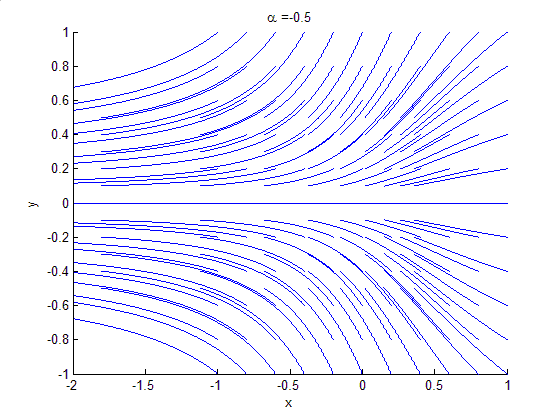Bifurcation theory
From Wikipedia, the free encyclopedia
Bifurcation theory is the mathematical study of changes in the qualitative or topological structure of a given family. Examples of such families are the integral curves of a family of vector fields or, the solutions of a family of differential equations. Most commonly applied to the mathematical study of dynamical systems, a bifurcation occurs when a small smooth change made to the parameter values (the bifurcation parameters) of a system causes a sudden 'qualitative' or topological change in its behaviour. Bifurcations occur in both continuous systems (described by ODEs, DDEs or PDEs), and discrete systems (described by maps).
Contents |
[edit] Bifurcation Types
It is useful to divide bifurcations into two principal classes:
- Local bifurcations, which can be analysed entirely through changes in the local stability properties of equilibria, periodic orbits or other invariant sets as parameters cross through critical thresholds; and
- Global bifurcations, which often occur when larger invariant sets of the system 'collide' with each other, or with equilibria of the system. They cannot be detected purely by a stability analysis of the equilibria (fixed points).
[edit] Local bifurcations
A local bifurcation occurs when a parameter change causes the stability of an equilibrium (or fixed point) to change. In continuous systems, this corresponds to the real part of an eigenvalue of an equilibrium passing through zero. In discrete systems (those described by maps rather than ODEs), this corresponds to a fixed point having a Floquet multiplier with modulus equal to one. In both cases, the equilibrium is non-hyperbolic at the bifurcation point. The topological changes in the phase portrait of the system can be confined to arbitrarily small neighbourhoods of the bifurcating fixed points by moving the bifurcation parameter close to the bifurcation point (hence 'local').
More technically, consider the continuous dynamical system described by the ODE
A local bifurcation occurs at (x0,λ0) if the Jacobian matrix  has an eigenvalue with zero real part. If the eigenvalue is equal to zero, the bifurcation is a steady state bifurcation, but if the eigenvalue is non-zero but purely imaginary, this is a Hopf bifurcation.
has an eigenvalue with zero real part. If the eigenvalue is equal to zero, the bifurcation is a steady state bifurcation, but if the eigenvalue is non-zero but purely imaginary, this is a Hopf bifurcation.
For discrete dynamical systems, consider the system
Then a local bifurcation occurs at (x0,λ0) if the matrix  has an eigenvalue with modulus equal to one. If the eigenvalue is equal to one, the bifurcation is either a saddle-node (often called fold bifurcation in maps), transcritical or pitchfork bifurcation. If the eigenvalue is equal to -1, it is a period-doubling (or flip) bifurcation, and otherwise, it is a Hopf bifurcation.
has an eigenvalue with modulus equal to one. If the eigenvalue is equal to one, the bifurcation is either a saddle-node (often called fold bifurcation in maps), transcritical or pitchfork bifurcation. If the eigenvalue is equal to -1, it is a period-doubling (or flip) bifurcation, and otherwise, it is a Hopf bifurcation.
Examples of local bifurcations include:
- Saddle-node (fold) bifurcation
- Transcritical bifurcation
- Pitchfork bifurcation
- Period-doubling (flip) bifurcation
- Hopf bifurcation
- Neimark (secondary Hopf) bifurcation
[edit] Global bifurcations
Global bifurcations occur when 'larger' invariant sets, such as periodic orbits, collide with equilibria. This causes changes in the topology of the trajectories in the phase space which cannot be confined to a small neighbourhood, as is the case with local bifurcations. In fact, the changes in topology extend out to an arbitrarily large distance (hence 'global').
Examples of global bifurcations include:
- Homoclinic bifurcation in which a limit cycle collides with a saddle point.
- Heteroclinic bifurcation in which a limit cycle collides with two or more saddle points.
- Infinite-period bifurcation in which a stable node and saddle point simultaneously occur on a limit cycle.
- Blue sky catastrophe in which a limit cycle collides with a nonhyperbolic cycle.
Global bifurcations can also involve more complicated sets such as chaotic attractors.
[edit] Codimension of a bifurcation
The codimension of a bifurcation is the number of parameters which must be varied for the bifurcation to occur. This corresponds to the codimension of the parameter set for which the bifurcation occurs within the full space of parameters. Saddle-node bifurcations are the only generic local bifurcations which are really codimension-one (the others all having higher codimension). However, often transcritical and pitchfork bifurcations are also often thought of as codimension-one, because the normal forms can be written with only one parameter.
An example of a well-studied codimension-two bifurcation is the Bogdanov-Takens bifurcation.
[edit] See also
[edit] References
- Nonlinear dynamics
- Bifurcations and Two Dimensional Flows by Elmer G. Wiens
- Introduction to Bifurcation theory by John David Crawford





